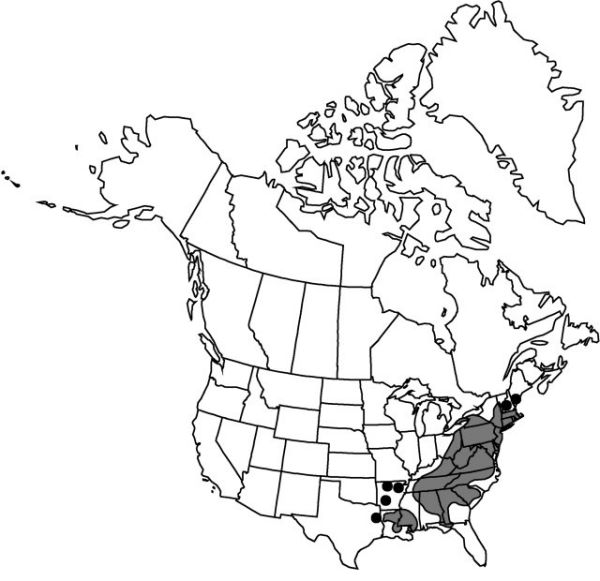Uvularia perfoliata
Sp. Pl. 1: 304. 1753.
Rhizomes short, ca. 1 cm, bearing numerous, clustered, fleshy roots and 1–2 slender, elongate, white stolons to 1.5 dm. Stems 1–several, simple or 1-branched, rounded, 1.5–5 dm, glaucous, bearing (2–)3–4 leaves below lowest branch. Leaf blades perfoliate, ovate to ovate-oblong, 4–20(–12.5) × 1.5–4(–6) cm, glaucous and smooth abaxially, margins smooth, apex acute to short-acuminate. Flowers 1 per stem; peduncles 1–2 cm, bearing 1 perfoliate bract; tepals straw-yellow, (15–)20–35 × 3–5 mm, orange-papillose adaxially, apex acute; stamens 10–15 mm; anthers 6–10 mm; connectives 1 mm; ovary sessile, obovoid; style 8–10 mm; stigma lobes 3–5 mm. Capsules obovoid-truncate, 3-lobed, 0.7–1.3 × 1–1.6 cm, 2 attenuate beaks per lobe. Seeds 2.5–4.5 mm; arils membranaceous. 2n = 14.
Phenology: Flowering spring–early summer.
Habitat: Deciduous woods and upland thickets, acid to neutral soils
Elevation: 0–1000 m
Distribution

Ont., Ala., Ark., Conn., Del., D.C., Fla., Ga., Ky., La., Maine, Md., Mass., Miss., N.H., N.J., N.Y., N.C., Ohio, Pa., R.I., S.C., Tenn., Tex., Vt., Va., W.Va.
Discussion
Detailed life-history studies of Uvularia perfoliata (D. F. Whigham 1974; D. K. Wijesinghe and D. F. Whigham 1997, 2001; H. Kudoh et al. 1999) have established the genetic basis of its clonal structure.
Uvularia pudica Fernald is an illegitate name that pertains here.
Selected References
None.